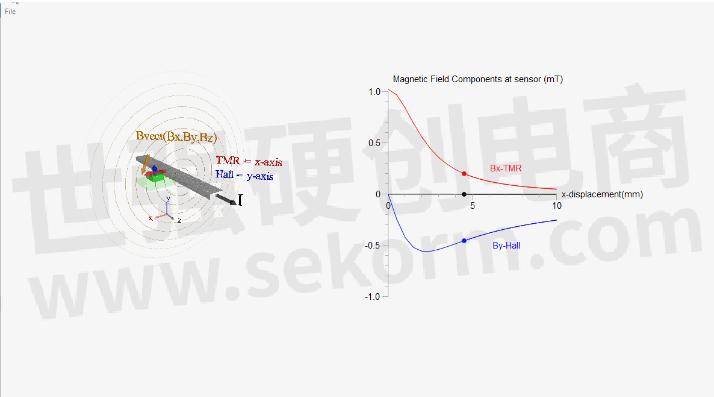Advantage of Crocus TMR Axis of Sensitivity for Crosstalk and Current Trace Density

The magnetic field produced by current confined to a wire or busbar is expressed as circular field lines around the wire. A Crocus TMR sensor has an axis of sensitivity tangential to circular field lines, which is optimal for current sensing. The typical Hall sensor axis of sensitivity is planar or normal to the surface of the IC, which is non-optimal for sensing the circular field from a current trace. Sensor axis of sensitivity and trace routing are very important considerations for system-level crosstalk.

Current in adjacent traces will produce circular fields, so current routed by traces in proximity and parallel to the current being sensed will produce unwanted field sensed as cross talk. For a given layout, the Crocus TMR axis of sensitivity parallel to the PCB will reduce crosstalk by order of magnitude relative to Hall-based sensors. In application, the lower crosstalk from the Crocus TMR axis of sensitivity enables more accurate measurements and allows a higher density of current traces on a PCB. As shown below a Crocus TMR sensor is impacted by 2% from a stray magnetic field 10mm away while a Hall sensor is impacted by 50%. The result is a low noise, high sensitivity Crocus TMR current sensor, enabling more accurate, stable measurements, resulting in superior performance.
- +1 Like
- Add to Favorites
Recommend
- Nxp Licenses Advanced TMR Sensor Technology From Crocus Technology
- Suncall Corporation Taps Crocus Technologies TMR Sensor Technology to Develop Advanced Sensors for EV Industry
- Crocus Technology Surpasses 100 million Delivered Units of its CMOS-Integrated XtremeSense® TMR Sensor Citing Design Wins and Rapid Market Adoption of TMR Technology
- Crocus’ XtremeSense® TMR CT81xx Sensors: a Combination of High Sensitivity, Low Power and Small Footprint for Medical Wearables Applications
- Crocus Technology Launches First True Z-axis TMR Sensor Delivering Unparalleled Performance for Next-Gen Position and Current Sensing Applications
- TMR3101 from MDT,the First Absolute Rotary Encoder Featuring Tunneling Magnetoresistance (TMR) Sensor Technology
- MDT Announced 100DPI TMR Magnetic Image Sensors and Full Range of Magnetic Pattern Recognition Sensors at Electronica 2018
- Crocus TMR Sensors with Higher Sensitivity, Better Linearity and Less Temperature Sensitivity Are Becoming More Popular in EV BDUs
This document is provided by Sekorm Platform for VIP exclusive service. The copyright is owned by Sekorm. Without authorization, any medias, websites or individual are not allowed to reprint. When authorizing the reprint, the link of www.sekorm.com must be indicated.





























































































































































































































































































































































































































































































































































































































































































































































































































































































